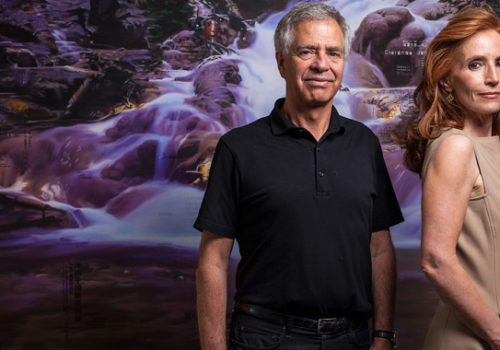Founded in 2005 by Dominique and Sylvain Lévy, the DSL Collection is one of the few collections of contemporary Chinese art in France. Sylvain and Dominique Lévy have been collectors for over twenty-five years, focusing mainly on contemporary Western artists and designers. During a trip to Shanghai in 2005, they visited the studio of abstract painter Ding Yi and became instant and lasting Sinophiles.
The Lévys started the noble mission of putting together a collection of contemporary Chinese art in order to make it accessible to everyone, with a reliance on new technology: they have already held an online exhibition and developed an iPad application, among other endeavors. Knowing that the virtual experience cannot match a direct encounter with the work, they gladly loan out their works to museums and other cultural institutions.
With a collection of never more than 200 works featuring painting, videos, installations and performance art, the Lévys own pieces by some of the biggest names in contemporary Chinese photography, including Miao Xiaochun, Rongrong, Shen Qi, Shi Guorui, Wang Qingsong, Yang Yongliang and Zhang Dali. Somewhere between a democratization of art and an institutional approach (reflected in its values of conservation, transmission, education and exhibition), the DSL Collection’s strengths lie in its eternal renewal and its impact on an international audience.
Marine Cabos: Miao Xiaochun, Rongrong, Shen Qi, Wang Qingsong and many other illustrious names can be found in your collection. Among all these photographers, is there one (or several) of which you are particularly fond?
Sylvain Lévy: I don’t have a preference. What’s important is the work itself, that it demonstrates courage, the artist’s creativity and why it is relevant in the collection.
MC: What role do you think Chinese photography plays in the contemporary art market?
SL: For the time being, I don’t think that Chinese photography is very present or influential in the contemporary art market.
MC: Do you think that contemporary Chinese photography possesses its own characteristics?
SL: Yes, I think so. Early Chinese photography was often used to “capture” performances of a political or social nature. Subsequently, it became more of a visual art, which I find less interesting.
MC: Some people in the contemporary Chinese art world believe that Chinese art needs a few more years to reach maturity. What do you think of this view?
SL: I believe it’s true. What we call contemporary Chinese art is less than thirty years old. It’s a complex blend of tradition and modernity, characteristics specific to China and to the world, and all of that in a highly complicated socio-political context.
MC: What’s next for the DSL Collection?
SL: Right now we’re working on a new catalogue of the collection that will highlight the work of a new generation of artists alongside more established ones. We are also increasingly active on social networks.
















